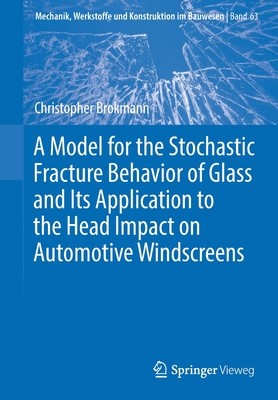
- We will send in 10–14 business days.
- Author: Christopher Brokmann
- Publisher: Springer Vieweg
- ISBN-10: 3658367873
- ISBN-13: 9783658367879
- Format: 17 x 24.4 x 0.9 cm, minkšti viršeliai
- Language: English
- SAVE -10% with code: EXTRA
A Model for the Stochastic Fracture Behavior of Glass and Its Application to the Head Impact on Automotive Windscreens (e-book) (used book) | bookbook.eu
Reviews
Description
The book deals with the stochastic strength of glass and the application to the automotive windscreen. A finite element model is derived. This is then validated using known phenomena in connection with the fracture behaviour of glass. After the strength of a windscreen has been intensively investigated, experiments with wind windscreen, experiments with windscreens are simulated by means of the model. Finally, the probability of a pedestrian suffering a head injury on impact with a windscreen is predicted. of a pedestrian hitting a windscreen is predicted, taking into account the stochastic breakage behaviour of glass. Up to now, this has not been taken into account in EuroNCAP crash tests, for example.
EXTRA 10 % discount with code: EXTRA
The promotion ends in 21d.09:20:19
The discount code is valid when purchasing from 10 €. Discounts do not stack.
- Author: Christopher Brokmann
- Publisher: Springer Vieweg
- ISBN-10: 3658367873
- ISBN-13: 9783658367879
- Format: 17 x 24.4 x 0.9 cm, minkšti viršeliai
- Language: English English
The book deals with the stochastic strength of glass and the application to the automotive windscreen. A finite element model is derived. This is then validated using known phenomena in connection with the fracture behaviour of glass. After the strength of a windscreen has been intensively investigated, experiments with wind windscreen, experiments with windscreens are simulated by means of the model. Finally, the probability of a pedestrian suffering a head injury on impact with a windscreen is predicted. of a pedestrian hitting a windscreen is predicted, taking into account the stochastic breakage behaviour of glass. Up to now, this has not been taken into account in EuroNCAP crash tests, for example.


Reviews